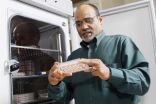(Press-News.org) CAMBRIDGE, Mass. -- Researchers at MIT have revealed exactly how a molecule called fulvalene diruthenium, which was discovered in 1996, works to store and release heat on demand. This understanding, reported in a paper published on Oct. 20 in the journal Angewandte Chemie, should make it possible to find similar chemicals based on more abundant, less expensive materials than ruthenium, and this could form the basis of a rechargeable battery to store heat rather than electricity.
The molecule undergoes a structural transformation when it absorbs sunlight, putting it into a higher-energy state where it can remain stable indefinitely. Then, triggered by a small addition of heat or a catalyst, it snaps back to its original shape, releasing heat in the process. But the team found that the process is a bit more complicated than that.
"It turns out there's an intermediate step that plays a major role," said Jeffrey Grossman, the Carl Richard Soderberg Associate Professor of Power Engineering in the Department of Materials Science and Engineering. In this intermediate step, the molecule forms a semi-stable configuration partway between the two previously known states. "That was unexpected," he said. The two-step process helps explain why the molecule is so stable, why the process is easily reversible and also why substituting other elements for ruthenium has not worked so far.
In effect, explained Grossman, this process makes it possible to produce a "rechargeable heat battery" that can repeatedly store and release heat gathered from sunlight or other sources. In principle, Grossman said, a fuel made from fulvalene diruthenium, when its stored heat is released, "can get as hot as 200 degrees C, plenty hot enough to heat your home, or even to run an engine to produce electricity."
Compared to other approaches to solar energy, he said, "it takes many of the advantages of solar-thermal energy, but stores the heat in the form of a fuel. It's reversible, and it's stable over a long term. You can use it where you want, on demand. You could put the fuel in the sun, charge it up, then use the heat, and place the same fuel back in the sun to recharge."
In addition to Grossman, the work was carried out by Yosuke Kanai of Lawrence Livermore National Laboratory, Varadharajan Srinivasan of MIT's Department of Materials Science and Engineering, and Steven Meier and Peter Vollhardt of the University of California, Berkeley.
The problem of ruthenium's rarity and cost still remains as "a dealbreaker," Grossman said, but now that the fundamental mechanism of how the molecule works is understood, it should be easier to find other materials that exhibit the same behavior. This molecule "is the wrong material, but it shows it can be done," he said.
The next step, he said, is to use a combination of simulation, chemical intuition, and databases of tens of millions of known molecules to look for other candidates that have structural similarities and might exhibit the same behavior. "It's my firm belief that as we understand what makes this material tick, we'll find that there will be other materials" that will work the same way, Grossman said.
Grossman plans to collaborate with Daniel Nocera, the Henry Dreyfus Professor of Energy and Professor of Chemistry, to tackle such questions, applying the principles learned from this analysis in order to design new, inexpensive materials that exhibit this same reversible process. The tight coupling between computational materials design and experimental synthesis and validation, he said, should further accelerate the discovery of promising new candidate solar thermal fuels.
INFORMATION:
Funding: The National Science Foundation and an MIT Energy Initiative seed grant.
Source: "Mechanism of Thermal Reversal of the (Fulvalene) tetracarbonyldiruthenium Photoisomerization: Toward Molecular Solar–Thermal Energy Storage," by Yosuke Kanai, Varadharajan Srinivasan, Steven K. Meier, K. Peter C. Vollhardt, Jeffrey C. Grossman. Angewandte Chemie, 20 October, 2010.
Researchers find a stable way to store the sun's heat
Storing thermal energy in chemical could lead to advances in storage and portability
2010-10-26
ELSE PRESS RELEASES FROM THIS DATE:
Listeria clever at finding its way into bloodstream, causing sickness
2010-10-26
WEST LAFAYETTE, Ind. - Pathogenic listeria tricks intestinal cells into helping it pass through those cells to make people ill, and, if that doesn't work, the bacteria simply goes around the cells, according to a Purdue University study.
Arun Bhunia, a professor of food science, and Kristin Burkholder, a former Purdue graduate student who is now a postdoctoral researcher in microbiology and immunology at the University of Michigan Medical School, found that listeria, even in low doses, somehow triggers intestinal cells to express a new protein, heat shock protein 60, ...
Modern humans emerged far earlier than previously thought
2010-10-26
An international team of researchers based at the Institute of Vertebrate Paleontology and Paleoanthropology in Beijing, including a physical anthropology professor at Washington University in St. Louis, has discovered well-dated human fossils in southern China that markedly change anthropologists perceptions of the emergence of modern humans in the eastern Old World.
The research was published Oct. 25 in the online early edition of the Proceedings of the National Academy of Sciences.
The discovery of early modern human fossil remains in the Zhirendong (Zhiren Cave) ...
'Fracking' mobilizes uranium in marcellus shale
2010-10-26
BUFFALO, N.Y. -- Scientific and political disputes over drilling Marcellus shale for natural gas have focused primarily on the environmental effects of pumping millions of gallons of water and chemicals deep underground to blast through rocks to release the natural gas.
But University at Buffalo researchers have now found that that process -- called hydraulic fracturing or "fracking"-- also causes uranium that is naturally trapped inside Marcellus shale to be released, raising additional environmental concerns.
The research will be presented at the annual meeting of ...
Study finds race, ethnicity impact access to care for children with frequent ear infections
2010-10-26
Ear infections are one of the most common health problems for children, with most kids experiencing at least one by their third birthday. Annual costs in the United States alone are in the billions of dollars.
When these infections are left untreated, complications can include hearing loss, speech problems and more severe infections that can spread to bone and brain, causing meningitis. But not all kids have the same access to medical specialists and medicines.
A new study by researchers at the David Geffen School of Medicine at UCLA and Harvard Medical School has ...
Knowledge gaps, fears common among parents of children with drug-resistant bacteria
2010-10-26
Knowledge gaps and fear — some of it unjustified — are common among the caregivers of children with a drug-resistant staph bacterium known as MRSA, according to the results of a small study from the Johns Hopkins Children Center. These caregivers thirst for timely, detailed and simple information, the researchers add.
The study's findings, published online in The Journal of Pediatrics, underscore the need for healthcare staff to do a better job in educating parents, while also addressing concerns and allaying fears, the investigators say.
"What these results really ...
Growing crops in the city
2010-10-26
Madison, WI, October 25, 2010 – A case study published in the 2010 Journal of Natural Resources and Life Sciences Education by professors at Washington State University studies the challenges one organization faced in maintaining an urban market garden. The journal is published by the American Society of Agronomy.
Since 1995, Seattle Youth Garden Works (SYGW) has employed young homeless individuals or those involved in the juvenile justice system. SYGW offers teens and young adults the opportunity to work, develop social skills, and eventually find stable employment or ...
Newfoundland researchers crack the genetic code of a sudden death cardiac killer
2010-10-26
Montreal – Researchers in Newfoundland have cracked the genetic code of a sudden death cardiac killer.
As a result, they have developed a unique prevention program in which people with no symptoms, but with a suspect gene and a family history, are being implanted with internal cardiac defibrillators (ICDs) which can restart their hearts if they stop.
"Our discovery has led to a targeted genetic screening and individualized therapy that is significantly improving survival rates," Dr. Sean Connors told the Canadian Cardiovascular Congress 2010, co-hosted by the Heart ...
Cardiac wakeup call for Canadian kids
2010-10-26
"Sleep disorders in kids are on the increase. They are marching hand in hand with other increasing cardiovascular risk factors such as overweight and obesity, lack of physical activity, a poor diet, and high levels of unhealthy cholesterol," Dr. McCrindle today told the Canadian Cardiovascular Congress 2010, co-hosted by the Heart and Stroke Foundation and the Canadian Cardiovascular Society.
"Teens who experience more disordered sleep − in terms of duration, quality, and pattern − have a higher body mass index and a correspondingly higher risk of overweight ...
DGAC report offers food and nutrition practitioners insights on helping combat obesity epidemic
2010-10-26
St. Louis, MO, October 26, 2010 – In an insightful Commentary in the November issue of the Journal of the American Dietetic Association, Linda Van Horn, PhD, RD, Editor-in-Chief of the Journal, Chair of the Dietary Guidelines Advisory Committee, and Professor and Associate Dean, Northwestern University, Feinberg School of Medicine, highlights the key features and noteworthy findings of the 2010 US Dietary Guidelines Advisory Committee (DGAC) Report. While many of the recommendations from previous reports are reinforced, new evidence-based findings will help registered dietitians ...
Consuming polyunsaturated fatty acids may lower the incidence of gum disease
2010-10-26
St. Louis, MO, October 26, 2010 – Periodontitis, a common inflammatory disease in which gum tissue separates from teeth, leads to accumulation of bacteria and potential bone and tooth loss. Although traditional treatments concentrate on the bacterial infection, more recent strategies target the inflammatory response. In an article in the November issue of the Journal of the American Dietetic Association, researchers from Harvard Medical School and Harvard School of Public Health found that dietary intake of polyunsaturated fatty acids (PUFAs) like fish oil, known to have ...
LAST 30 PRESS RELEASES:
HKUST Engineering researchers developed a novel photodetector to enhance the performance of on-chip light monitoring
Strategic river sensors could have forewarned of Texas Camp flood disaster
Drone sampling of whale breath reveals first evidence of potentially deadly virus in Arctic
Roman soldiers defending Hadrian’s Wall infected by parasites, study finds
Pinochet’s prisoners were tormented with music but still found solace in it, a new book reveals
Fertility remains high in rural Tanzania despite access to family planning
AI-assisted device can improve autism care access
Kinetic careers
Uncovering how parasitic plants avoid attacking themselves to improve crop resistance
Nanoparticle vaccine strategy could protect against Ebola and other deadly filoviruses
Study finds brain care score can predict risk of stroke across racial groups
Key lung immune cells can intensify allergic reactions
Do hormones explain why women experience more gut pain?
New materials conduct ions in solids as easily as in liquids
Breakthrough of the Year: Renewable energy begins to eclipse fossil fuel-based sources
LLM use is reshaping scientific enterprise by increasing output, reducing quality and more
Introducing LightGen, a chip for ultra-fast, ultra-efficient generative AI
Astronomers see fireworks from violent collisions around nearby star
ACC/AHA issue new guideline on managing congenital heart disease in adults
Cosmic crash caught on camera
Is talented youth nurtured the wrong way? New study shows: top performers develop differently than assumed
Ants: An untapped resource in the development of antibiotics?
Archaeologists use AI to create prehistoric video game
Mitochondria migrate toward the cell membrane in response to high glucose levels
Tiny viral switch offers hope against drug-resistant bacteria
Most parents aware of early peanut introduction guidelines, but confused about details
HPV vaccine can protect against severe lesions of the vulva and vagina
Virtual care provision and emergency department use among children and youth
Quadrivalent HPV vaccine and high-grade vulvovaginal lesions
Insights into dry eyes gained from stem cell-derived tear glands
[Press-News.org] Researchers find a stable way to store the sun's heatStoring thermal energy in chemical could lead to advances in storage and portability

